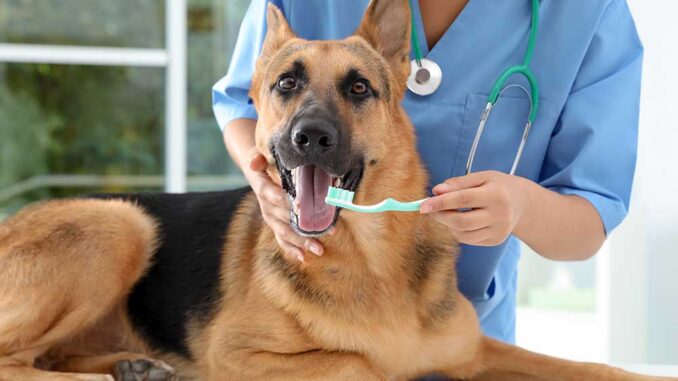
As a veterinarian, I have performed my share of dental cleanings on dogs, so I understand concerns about the cost of treatment. One thing I can attest to is that the cost goes up if you don’t practice good hygiene at home with your dog.
In this article, we’ll look at dental cleaning in dogs: why vets recommend it, and how it benefits your pooch. To help with your budget, I’ll discuss low-cost options you may be able to try, and when you need professional cleaning. I’ll conclude with things you can do at home to promote healthy teeth and gums and minimize the need for dental cleanings.
Overview of dental cleaning in dogs
While many owners treat dental cleaning as optional for their dogs, it should be viewed as an essential part of your furbaby’s health care. Our four-footed friends suffer from the same conditions as we do:
- Plaque buildup
- Tartar
- Gum disease
- Tooth decay
- Abscesses
- Tooth loss
Without professional dental exams and cleaning, you may be leaving your furbaby at risk for dental disease. Cornell’s College of Veterinary Medicine indicates that 80-90% of dogs over 3 years old have some level of periodontal disease.
During your annual health check, your veterinarian will examine your pup’s teeth to check for tartar and early signs of gum disease (gingivitis). If he detects an issue, he’ll recommend a dental cleaning. The procedure helps to remove tartar buildup and prevent periodontal disease.
Dental cleanings usually occur while your dog is under anesthesia. Sedation allows your veterinarian to remove tartar from the teeth and under the gumline.
Before the cleaning, your vet will carefully examine the mouth, including under the gum line, and take x-rays to see under the surface of the teeth and gums. Once the initial exam occurs, he will remove tartar and dental calculi. If there are damaged teeth, he may repair or extract them, depending on the condition and severity.
Regular dental cleanings can help catch minor issues and inflammation before your dog has severe problems. The frequency of the procedure varies depending on your dog’s breed, age, and overall health. Consult with your veterinarian to determine how often your pooch needs professional cleaning.
Low-cost dental cleaning options for dogs
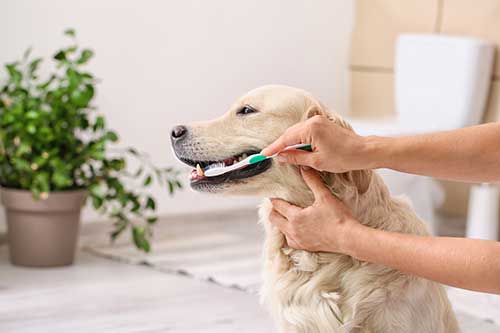
Your dog will need routine dental cleaning to promote oral health. What can you do to keep your furbaby’s teeth clean without breaking the bank? Let’s look at the options available to you.
1. Anesthesia-free dental cleanings – how much do they cost?
You may have heard about dental cleanings without anesthesia or seen advertising from a local groomer offering this service. Some veterinary clinics also offer it. With this procedure, the groomer or other professional scrapes plaque and tartar from the visible surfaces of your dog’s teeth using a metal instrument known as a scaler.
Anesthesia-free dental cleanings cost about $100-$300 depending on the location of the service and the size of your dog. It will only work with compliant dogs that can be safely handled or restrained by other people.
During the “cleaning,” your dog has to be restrained with his mouth open to allow the person to descale the teeth. Because there’s no anesthesia, your dog can go home as soon as the procedure is completed. However, the restraint and process can be stressful for your pooch and may put the worker and your dog at higher risk of injury.
Appearances can be deceiving. While anesthesia-free cleanings are usually less expensive and leave the visible surfaces of the teeth clean and stain-free, there’s no effective way to clean beneath the gumline. Owners come away from the experience with a false sense of well-being for their beloved dog. Meanwhile, plaque, tartar, and bacteria may fester under the gums and cause periodontal disease.
2. Dental cleanings with anesthesia
Dental cleanings with anesthesia generally cost between $500 and $1700+ dollars depending on:
- The clinic’s location
- Your dog’s age and size
- The type of bloodwork required
- Your dog’s health status
- The condition of your dog’s teeth
- Whether any extractions or additional dental work is needed
The average cost of routine cleaning is $700-1000. If your dog requires additional care such as tooth extractions, it can run $15-100 per tooth depending on whether it’s a simple procedure or requires a drill. Root canals may add $1000-3000 per tooth.
There may be a few local options to help you lower the cost of professional cleaning.
- PetSmart vet clinics offer low-cost veterinary dental cleanings that can be as low as $200-400. This service is not equipped to manage involved dental care like extractions or root canals.
- Banfield Pet Hospitals offer more complete dental services including x-rays and extractions, but the cost is higher, averaging around $350-450.
- The cost of a basic dental cleaning at VetCo/PetCo is around $300. The company does not handle more complicated dental procedures.
- Pet Supplies Plus VIP vet care offers basic dental cleaning services at lower prices than most full-service veterinary clinics, but they’re usually not equipped to handle procedures like extractions and root canals.
- VCA Animal Hospitals offer dental care packages for your dog that include routine dental cleanings. Depending on where you live and your dog’s size, the packages start as low as $99.
- Veterinary schools often sponsor low-cost or free clinics. If you live near a vet school, contact them about affordable dental cleaning.
- The Animal Humane Society offers dental services. A basic cleaning generally costs $367.50, but discounts are available based on household income.
- Other local shelters may also provide affordable dental cleanings.
- Many Pet Insurance Companies have dental add-ons that include partial reimbursements for routine dental cleanings.
3. Home care
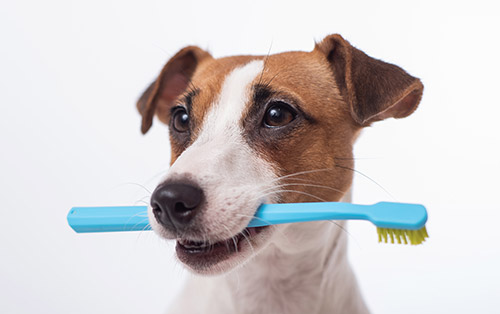
Basic hygiene practices at home can help maintain your dog’s oral health and may reduce the frequency of required dental cleaning.
- Brush your dog’s teeth daily with a vet-approved toothbrush and dog-safe toothpaste. Start slowly by placing the paste on your fingers and rubbing it on all the teeth. When your dog is comfortable, switch to the toothbrush. Use a circular motion and brush all surfaces of every tooth.
- Use dental wipes daily to remove plaque from the teeth. These are handy if your dog refuses to let you brush his teeth.
- Chlorhexidine oral gels or rinses help to fight plaque. If you use this option, choose a flavored variety. Many dogs don’t like the taste of the plain solution.
- Teeth-cleaning toys/chews feature ridges or nubs that rub against and between the teeth and gums when your dog chews on them. They help to clean some plaque from the tooth surface and stimulate healthy blood flow to encourage gum and tooth health.
- Dental treats to help remove plaque and tartar. Look for the Veterinary Oral Health Council’s seal to indicate that the chew is an effective preventative against tartar buildup.
- Feed a balanced diet that promotes dental health. If your dog resists brushing or wiping, consult with your veterinarian about a prescription dental food. These dry kibble formulas help reduce tartar buildup by cleaning the surfaces of the teeth.
When is dental cleaning really necessary?
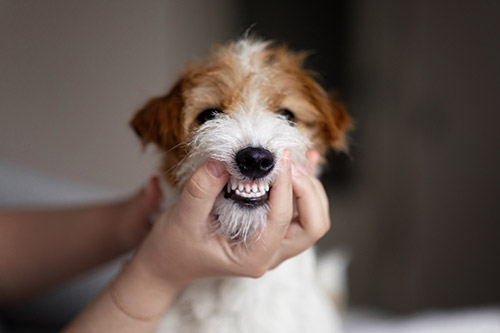
Dog with clean, white teeth and healthy gums. The owner of this dog could wait on dental cleaning and focus on good oral hygiene at home.
Generally, dogs should have dental cleanings once a year to remove plaque and tartar buildup and prevent dental disease. However, the frequency can vary based on your dog’s age, breed, and lifestyle/diet. Signs that your dog should have a professional dental cleaning include:
- Stinky or foul-smelling breath
- Red, inflamed gums
- Tartar buildup on teeth/discolored teeth
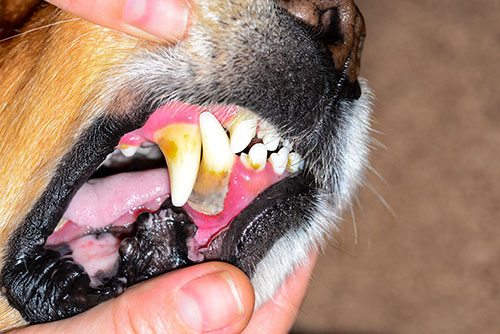
Notice the yellow and grey tartar buildup on the teeth of this dog. The gums also appear reddened. Without a dental cleaning, this dog will likely develop periodontal disease.
- Excessive salivation
- Gums that bleed easily when touched, or when you brush your dog’s teeth
- Difficulty eating/dropping food
- Broken or worn teeth
- Swelling in or around the mouth
- If your dog avoids his favorite chew toys
- When your vet tells you to do it
If your dog requires dental cleaning, don’t take a wait-and-see approach. At-home cleaning is not sufficient to remove hardened tartar from the teeth. When you leave the teeth alone, bacterial growth and infections are likely. Progressive periodontal disease can be painful for your dog and leads to abscesses or tooth decay.
After the dental cleaning, what can I do at home to avoid future dental cleanings?
You won’t be able to avoid dental cleanings, but you may be able to reduce the frequency. To minimize the need for professional cleanings:
- Brush your dog’s teeth daily using a circular motion to remove plaque. If they resist brushing, use oral wipes or a rinse/gel to fight plaque and tartar.
- Feed your dog a balanced diet to promote optimum health.
- Consider switching to a prescription dental diet to help prevent tartar buildup.
- Give your dog dental treats at least once a week to help scrape plaque from the teeth.
- Get dental chew toys to help clean the teeth.
Consult with your veterinarian about which of these measures will be most helpful to promote your dog’s oral health.
Frequently asked questions
How often should I have my dog’s teeth professionally cleaned?
Most dogs should have their teeth professionally cleaned once a year. However, your veterinarian can advise you about your furbaby’s dental health at his annual checkup.
Are non-anesthetic cleanings safe for all dogs?
The AVMA, American Veterinary Dental College, and American Animal Hospital Association all advise against non-anesthetic cleanings for dogs. The procedure is a safety risk for dogs and people, and it gives owners a false sense of security.
How can I find low-cost dental clinics near me?
Some ways to find low-cost dental clinics include calling your local humane society or animal shelter, consulting with your veterinarian, and checking with a veterinary school or veterinary technician school if there’s one near you.
Can I use human toothpaste for my dog?
You should only use dog-safe toothpaste for your dog. Human products often contain ingredients like xylitol that are potentially toxic for dogs.
Disclaimer: This website's content is not a substitute for veterinary care. Always consult with your veterinarian for healthcare decisions. Read More.


Be the first to comment